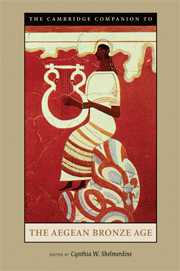Book contents
- Frontmatter
- 1 Background, Sources, and Methods
- 2 The Early Bronze Age in Greece
- 3 The Early Bronze Age in the Cyclades
- 4 Early Prepalatial Crete
- 5 Protopalatial Crete
- 6 The Material Culture of Neopalatial Crete
- 7 Minoan Culture: Religion, Burial Customs, and Administration
- 8 Minoan Crete and the Aegean Islands
- 9 Minoan Trade
- 10 Early Mycenaean Greece
- 11 Mycenaean Art and Architecture
- 12 Mycenaean States
- 13 Burial Customs and Religion
- 13A Death and the Mycenaeans
- 13B Mycenaean Religion
- 14 Mycenaean Greece, the Aegean and Beyond
- 15 Decline, Destruction, Aftermath
- Glossary
- Select Bibliography
- Index
- Plate section
13B - Mycenaean Religion
from 13 - Burial Customs and Religion
Published online by Cambridge University Press: 28 November 2010
- Frontmatter
- 1 Background, Sources, and Methods
- 2 The Early Bronze Age in Greece
- 3 The Early Bronze Age in the Cyclades
- 4 Early Prepalatial Crete
- 5 Protopalatial Crete
- 6 The Material Culture of Neopalatial Crete
- 7 Minoan Culture: Religion, Burial Customs, and Administration
- 8 Minoan Crete and the Aegean Islands
- 9 Minoan Trade
- 10 Early Mycenaean Greece
- 11 Mycenaean Art and Architecture
- 12 Mycenaean States
- 13 Burial Customs and Religion
- 13A Death and the Mycenaeans
- 13B Mycenaean Religion
- 14 Mycenaean Greece, the Aegean and Beyond
- 15 Decline, Destruction, Aftermath
- Glossary
- Select Bibliography
- Index
- Plate section
Summary
Sources for Reconstructing Ancient Religion
Reconstructing the religion of an ancient culture is hard work. Religious beliefs and practices consist of things thought, said, shown, and done. In the material record, we look for the locations where rituals were performed, the objects and materials used in ceremonies, and artistic representations (iconography) of such activities. If we are lucky, we will have written religious texts containing sacred myths that serve both as the “verbalization of ritual” and as a record of a culture’s religious belief system, their thoughts about how human beings relate to supra-human powers. Depending on how a religion is structured within a given society, such written documents can be fixed and canonical, or they can vary according to time and place. We may also have other texts (mainly inscriptions) that reflect what people are doing or are expected to do as forms of religious practice (often grouped together as “sacred laws”), who those people are (their religious titles, occupations, personal names), where they are doing these things, what they are using, and the obligations and benefits that motivate them.
The Nature of Written Sources for Mycenaean Religion
For Mycenaean religion, we have a limited amount of clear archaeological, iconographical, and artifactual data, and we have the information contained in the Linear B records. These tablets were produced, however, by anonymous tablet-writers in order to keep track of economic information related to the operation of the Mycenaean palatial centers (Chs. 1, p. 13; 12, pp. 291–2). We find in the Linear B tablets no myths, hymns, prayers, ritual prescriptions or laws, or sanctuary regulations; nor are there any inscriptions written by or for dedicators upon dedicated objects. The limitations and peculiarities of our archaeological and inscriptional data thus present interesting challenges.
- Type
- Chapter
- Information
- The Cambridge Companion to the Aegean Bronze Age , pp. 342 - 361Publisher: Cambridge University PressPrint publication year: 2008
- 5
- Cited by



